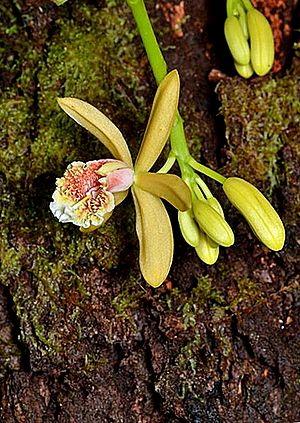Great climbing orchid facts for kids
Quick facts for kids Great climbing orchid |
|
|---|---|
 |
|
| Scientific classification | |
| Genus: |
Pseudovanilla
|
| Species: |
foliata
|
| Synonyms | |
The Pseudovanilla foliata, often called the great climbing orchid, is a special plant from the orchid family. You can find it growing naturally in Queensland and New South Wales in Australia, and also in New Guinea.
This orchid grows on the ground and climbs like a vine. It uses special roots that grow from its stem to help it climb. Its leaves are quite small. This plant gets some of its food from fungi in the soil, which is a unique way to live!
What Does It Look Like?
The great climbing orchid is a plant that lives for many years. It is a smooth vine, meaning it has no hairs. Its stem can be up to 0.9 cm (0.35 in) thick and can grow as long as 15 m (49 ft)! The stem is bendy and round, with leaves spread out along it.
Special climbing roots grow from the stem. These roots always have a small leaf-like part opposite them, which helps to identify the plant. The leaves are oval-shaped, pointed, and a bit thick. They can be up to 8 cm (3.1 in) long and 2.5 cm (0.98 in) wide.
The flowers grow in a loose but very branched cluster. Each branch can have 4 to 8 flowers at its tip. The main stem of the flower cluster is a bit swollen. The tiny leaves near the flowers are shaped like triangles.
The sepals (which look like petals) are long and narrow with rounded ends. They are about 2.6 cm (1.0 in) long and 0.6 cm (0.24 in) wide. The petals are also narrow and slightly curved. They are about as long as the sepals and 0.4 cm (0.16 in) wide.
The lip (a special petal) is about 2.1 cm (0.83 in) long and 1.6 cm (0.63 in) wide. It is broadly oval-shaped. Near the tip, it has three wavy lobes. The side lobes are rounded, and the middle lobe is like a half-circle with a small dip. The surface of the lip has bumpy parts and long, rounded bumps near its base.
The plant's column (the central part of the flower) is about 1 cm (0.39 in) long. The seed pods are long and cylindrical, measuring 15–25 cm (5.9–9.8 in) long and 4–5 cm (1.6–2.0 in) wide. This orchid usually flowers from October to January.
How It Was Named
The great climbing orchid was first officially described in 1861 by a scientist named Ferdinand von Mueller. He first called it Ledgeria foliata. Later, in 1873, he changed its name to Galeola foliata.
Then, in 1986, another scientist, Leslie Andrew Garay, gave it the name it has today: Pseudovanilla foliata.
Where It Lives
You can find Pseudovanilla foliata in Queensland, Australia, as far north as the Cape York Peninsula. It also grows in the northeast and central east parts of Queensland. Its most southern home is along the coast of central New South Wales. You can also find populations of this orchid in New Guinea.
This plant grows from sea level up to 1,000 m (3,300 ft) high. It likes to live in thick rainforests, both in lowlands and uplands. You'll often see it growing on living tree trunks or on rotting wood, like old tree stumps and logs.
Looking After This Orchid
The Queensland Government has listed Pseudovanilla foliata as a plant of "least concern" in their Nature Conservation Act 1992. This means that, for now, there are enough of these orchids, and they are not considered to be in danger.

